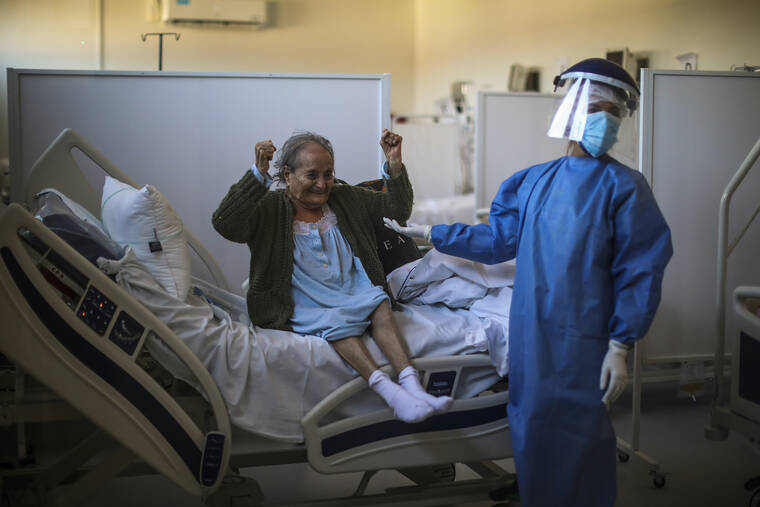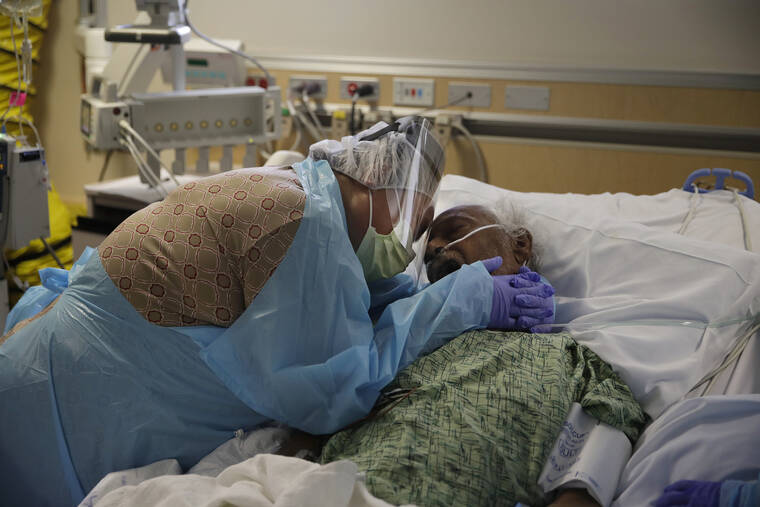2 years into pandemic, world takes cautious steps forward

Blanca Ortiz, 84, celebrates after learning from nurses that she will be dismissed from the Eurnekian Ezeiza Hospital, on the outskirts of Buenos Aires, Argentina, on Aug. 13, 2020, several weeks after being admitted with COVID-19. (AP Photo/Natacha Pisarenko)

Romelia Navarro, 64, weeps while hugging her husband, Antonio, in his final moments in a COVID-19 unit at St. Jude Medical Center in Fullerton, Calif., July 31, 2020. (AP Photo/Jae C. Hong)
PORTLAND, Ore. — With COVID-19 case numbers plummeting, Emily Safrin did something she hadn’t done since the pandemic began two years ago: She put her fears aside and went to a concert.
PORTLAND, Ore. — With COVID-19 case numbers plummeting, Emily Safrin did something she hadn’t done since the pandemic began two years ago: She put her fears aside and went to a concert.
The fully vaccinated and boosted restaurant server planned to keep her mask on, but as the reggaeton star Bad Bunny took the stage and the energy in the crowd soared, she ripped it off. Soon after, she was strolling unmasked in a trendy Portland neighborhood with friends.
Two years after the World Health Organization declared COVID-19 a pandemic, changing the world overnight, relief and hope are creeping back in after a long, dark period of loss, fear and deep uncertainty about the future.
“Everyone was supposed to be vaccinated or have a negative test, and I said, ‘What the heck, I’m just gonna live my life,’” Safrin said of her concert experience. “It was overwhelming, to be honest, but it also felt great to be able to just feel a little bit normal again.”
The world is finally emerging from a brutal stretch of winter dominated by the highly contagious omicron variant, bringing a sense of relief on the two-year anniversary of the start of the pandemic.
It was March 11, 2020 when the WHO issued its declaration, driving home the severity of the threat faced by a virus that at that point had wreaked havoc primarily in Italy and China. The U.S. had 38 confirmed coronavirus deaths and 1,300 cases nationwide on that date, but reality was starting to sink in: stocks tanked, classrooms started closing and people began donning masks. In a matter of hours, the NBA was canceling games, Chicago’s huge St. Patrick’s Day parade was scuttled and late-night comedians began filming from empty studios — or even their homes.
Since then, more than 6 million people have died globally, nearly 1 million in the U.S. Millions have been thrown out of work, students have endured three school years of disruptions. The emergence of the vaccine in December 2021 saved countless lives but political divisions, hesitancy and inequality in health systems have kept millions of people around the world from getting inoculated, prolonging the pandemic.
The situation is improving, however.
Hospitalizations of people with COVID-19 have plummeted 80% in the last six weeks across the U.S. since a mid-January pandemic peak, dropping to the lowest levels since July 2021, according to data from the Centers for Disease Control and Prevention. Case counts have followed the same trend line to the lowest counts since last summer as well. Even the death tally, which typically lags behind cases and hospitalizations, has slowed significantly in the last month.
In its latest pandemic report, the WHO said infections and deaths are down across the globe, with only one region — the Western Pacific — seeing a rise in cases. The Middle East and Africa saw cases drop by 46% and 40%, respectively.
Another positive: The omicron wave and vaccinations have left enough people with protection against the coronavirus that future spikes will likely require much less disruption to society, experts say.
Nowhere is the shift in the pandemic more apparent than in the nation’s hospitals, where critical care units were overflowing with desperately ill patients just months ago.
Julie Kim, chief nursing officer at Providence St. Jude Medical Center in Fullerton, California, gets emotional when she recalls the bleakest days of the pandemic when doctors and nurses worked around the clock and didn’t go home because they were afraid of bringing the virus back with them.
At one point during the summer 2020 spike, there were 250 COVID-19 patients in the hospital licensed for 320 beds and the hospital had to use offices for overflow bed space.
The pandemic has eased to the point that as of Tuesday, there were just four COVID-19 patients at the hospital, Kim said, and medical staff feels more prepared to treat the disease with the knowledge gained in those darkest days. Still, many are traumatized by the raw memories of the past two years and will never be the same, she said.
“It’s hard to use the word ‘normal,’ because I don’t think we will ever get back to a pre-COVID state. We are adapting and we are moving forward,” Kim said. “This has had a toll on many of us. Some people are moving forward and some people are still having a hard time dealing with it all.”
Mask mandates, vaccine requirements and other COVID-19 measures are being eliminated everywhere. The last statewide mask mandate in the U.S., in Hawaii, will end in two weeks.
But health experts are also urging some caution.
Dr. Albert Ko, an infectious-disease physician and epidemiologist at the Yale School of Public Health, said it’s certainly good news that the U.S. seems to be at the tail end of a peak. But he cautioned against any victory declarations, especially with the potential of another variant lurking around the corner.
“We have new variants emerge and those new variants fuel large waves, epidemic waves,” Ko said. “The big question is, are they going to be as mild or less severe as omicron? Are they going to be potentially more severe? Unfortunately, I can’t predict that.”


